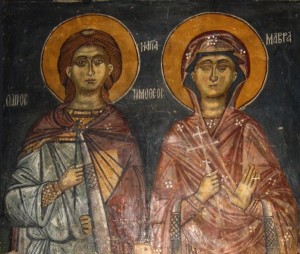Dear Father John, I have recently returned to St. Theresa of Avila’s autobiography, having only gotten through a third of it last year. It is easier to read now. I have an idea of where I am spiritually according to her book and will discuss this with my Redemptorist Spiritual Director. But I have a question. What I am seeking is: What is written for married women that is of the value of St. Teresa’s book about spiritual growth? I can’t see how a married woman can progress to the third (and further) stages when her vocation is to her husband. It’s not that God is taking me further, at this point, but I also do not want to stall myself.

This is a great question, and I am sorry to say that I only have a short answer: there is no such book – at least, not yet. Really! Up to now, the greatest spiritual writers have all been men and women called to the celibate state of life – priests and consecrated men and women.
New Spiritual Directions
One of the main emphases of the Second Vatican Council was to encourage the development of a more robust spirituality for those called to the married state. The Council Fathers seemed to perceive that the coming age of the Church was going to show a new blossoming of holiness among non-consecrated men and women. Pope John Paul II, following up on this insight, made a concerted effort to promote the cause for canonization of lay men and women. Personally, I firmly believe that the burgeoning new Ecclesial Movements, all of which encourage a dynamic pursuit of holiness among non-consecrated lay people, is a further sign of this impetus of the Holy Spirit. I also find it remarkable that one of the best books of spiritual theology that has been published in recent decades was written by a layman, Ralph Martin: The Fulfillment of All Desire. Nevertheless, even this book focuses on principles of the spiritual life as explained by the great writers of the past. He alludes to the differences inherent in the different states of life, but doesn’t develop them systematically. So the book you are looking for remains to be written. And I don’t see why you couldn’t be the one to write it. What do the Mansions of St. Teresa look like in the married state? What do the more advanced stages of prayer and virtue look like in the married state? What do the Dark Nights look like for a married woman, as opposed to a nun? What does the prayer of union look like in the marriage state?… Surely they won’t look exactly the same in both states of life. We know for certain that great holiness can be achieved in the married state (because of all the canonized saints who have been married), but so far we have not had a spiritual writer of the caliber of St. Teresa who experienced it, reflected on it, and wrote exhaustively about it.
Hope Springs Eternal
Nevertheless, you are not completely in the dark. Let me make a few suggestions, before asking our other readers to do the same. First of all, one of the best spiritual-growth books of all time was written as advice to a lay person: Introduction to the Devout Life by St. Francis de Sales. Admittedly, he doesn’t examine the different levels of holiness or prayer, but he does provide dependable and brilliant insights into what virtue in the lay state ought to look like. If you haven’t read it, get it; if you have read it, read it again! Secondly, you can begin to read good biographies of married saints, of wives and mothers who achieved spiritual maturity in this life. These are case-studies, not systematic presentations, but they will surely inspire and instruct you. This would include biographies of saints who were married, but after being widowed entered religious life (St. Rita of Cascia, St. Elizabeth Ann Seton). But the married saints are the ones you should look into first: St. Gianna Molla, St. Elizabeth of Hungary, St. Margaret of Scotland… But you may want to start with the spiritual diary of Servant of God, Elisabeth Leseur, a long-suffering Catholic wife of a prominent French atheist. At this point, I invite our readers to correct all my exaggerations and make all the recommendations they can think of.
+
Art: Icon of married Saints Timothy and Maura, unknown provenance, provided by Dan Burke from his personal library.




